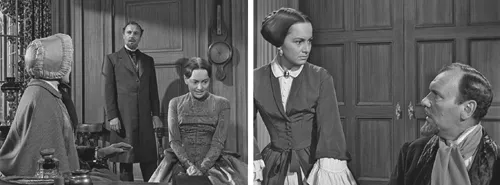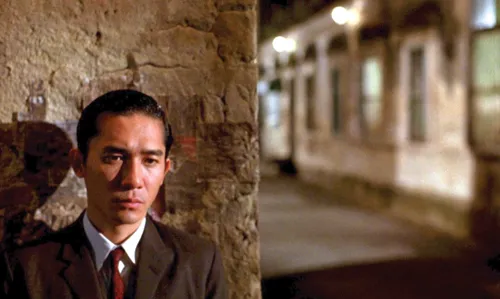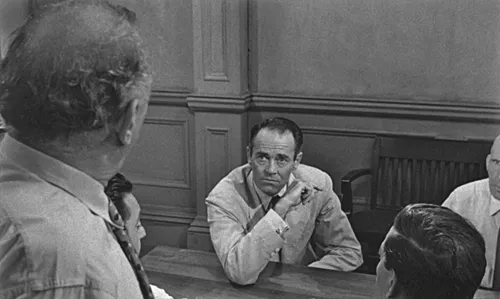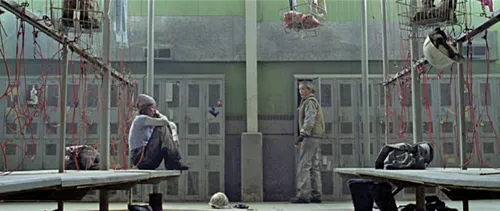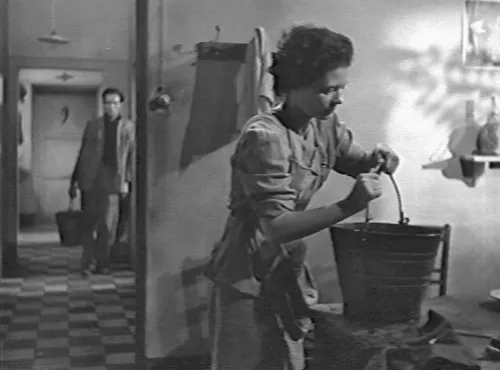![]()
PART ONE
Technique and Meaning
![]()
1 Composition
If you pause a movie, you see something resembling a photograph. The difference is that everything inside the movie image consists of artificially arranged elements that have been deliberately assembled to resemble real life. Little of what you see in a movie image is accidental.
The composition of images is an important way for filmmakers to communicate ideas and tell a story. An important feature of any composed image is the placement of the frame. The frame can be close to the object filmed (tight) or far away (loose). Each creates a different semantic effect.
The image from Mildred Pierce (1945) is tightly framed, and there is very little empty space around the figures. The image draws on the limited frame space of the Academy Ratio (1.35:1) to portray Mildred as trapped by representatives of the law. She has attempted to pin a murder on a friend in order to protect her daughter, but she has also strayed from prevailing gender norms by getting a divorce and becoming a successful businesswoman. She is being constrained by the police for both “crimes.”
FIGURE 1.1 Mildred Pierce. The tight frame of the image is suited to the idea that Mildred’s amoral urges are being contained by the law.
By contrast, the loosely framed image from The Searchers (1956) creates a very different meaning effect. It draws on the resources of the widescreen aspect ratio of 1.75:1 to create a feeling of a dangerous empty space around the figures. The wide-angle image embodies the movie’s theme—that civilization is a fragile construct whose institutions could easily be destroyed.
FIGURE 1.2 The Searchers. The widescreen frame format and the open frame allow empty space to be a more pronounced element of meaning.
The arrangement of objects within the frame obeys certain commonsense principles of valuation or inflection. A filmmaker usually assigns greater importance or value to characters who are centered within the frame or who are located in the upper half of the image. Characters who are of less value or who are subordinated in some way are often placed in the lower half or off to the side. The lower half of the image generally serves the function of an adjective of diminishment.
For example, in The Heiress (1949), a father and daughter disagree over who she should marry. The father is domineering, and he makes certain she does not marry a man she loves because the father suspects, rightly, that the man is a gold digger who wants the girl’s wealth. In the first image from early on in the film, the father is centered and in the upper part of the screen. At this point in the film, he is alerting his daughter to the danger she faces by marrying someone who does not love her. His dominant position in her life is suggested by his placement in the image. In the second image, from later in the film, the daughter stands up to him. She accuses him of having stolen from her the one chance she had for a romantic relationship in her life. She is now in the upper half of the screen and he is in the lower half.
FIGURE 1.3 AND 1.4 The Heiress. Composition depicts changing relations of power between a daughter and her domineering father.
The meaning of these common uses of space and location varies. It is not always the case that someone high in the frame has more power or value, or that someone lower has less. Sometimes a primary character will be placed off to the side to evoke pathos or empathy. In this image from In the Mood for Love (2000), for example, a character is placed in the lower left quadrant of the image. But this placement is not negative, nor is it a demotion in value. He has just learned that his wife is having an affair with another man; he feels betrayed, and the seemingly negative placement is designed to evoke our sympathy for him.
FIGURE 1.5 In the Mood for Love. A character’s suffering is suggested by his placement in the frame.
The placement of the character from In the Mood for Love is in keeping with cinematographers’ preferences for placement within the image. According to cinematography’s rule of thirds, if you divide an image into three parts both vertically and horizontally, you will get four points where four squares intersect, and those are favored by cinematographers in their effort to design balanced and unified images.
FIGURE 1.5A According to the rule of thirds, the object filmed should be aligned with the points of intersection on the grid.
Important characters can also be placed low in the frame to show that they are victims of injustice. In the image from Enemy of the State (1998), a man who is virtuous and who is about to be murdered is low in the frame. But in this instance, the positioning is meant to convey superiority. He is about to be harmed by the man to the left who looms over him in a threatening manner. In this instance, the fact that the man lower in the frame is centered in the image is more important than his inferior location.
FIGURE 1.6 Enemy of the State. A lower position in the frame evokes empathy.
In 12 Angry Men, a positive character occupies both upper and lower positions in successive images. A single juror (#8) holds out for “Not Guilty” in a murder trial. Eventually, he convinces all of the other jurors, but the process is difficult and laced with conflict. In the early sequences, Juror #8 is depicted standing over the other jurors to suggest the rightness of his position, but he is also placed in a lower position within compositions early i n the film to show how difficult his task is. Nevertheless, despite having other jurors standing over him, he is frequently centered to suggest the virtue of his position in comparison to theirs. They may dominate the visual space (and the argument), but one senses visually that he is right.
FIGURE 1.7 12 Angry Men. Placement within the frame often tells us visually who has virtue or power.
FIGURE 1.8 Before the Devil Knows You’re Dead. One character is assigned more space in the image to connote his dominance over the other.
The way space is distributed in the image can also be used to make meaning. Characters can occupy different amounts of space in relation to one another. In Before the Devil Knows You’re Dead (2007), Hank and Andy are brothers who need money and who decide to rob their parents’ jewelry store. The robbery goes awry, and their mother is killed. Andy dominates Hank in this tale of betrayal within a family, and that fact is registered both by his superior position and by the greater amount of space he is assigned in this image.
FIGURE 1.9 North Country. Negative space augments the character’s sense of alienation and anguish at this point in the film.
FIGURE Before the Devil Knows You’re Dead. One character is assigned more space in the image to connote his dominance over the other.
Empty space is often used for semantic emphasis. In the image from North Country (2005), a film about the first lawsuit brought against a corporation for sexual harassment, a single mother, Josey Aimes, a female worker at a mine, sits in despair after being bullied by a male coworker. The imbalance between her small figure and the huge empty space around her does a good job of portraying the greater power of the corporation in relation to her. She has been made to feel small, and the unbalance between figure and space in the frame provides a perfect correlate for her emotional state.
FIGURE 1.10 Bicycle Thieves. A wife’s silent labor on behalf of her family is foregrounded, foreshadowing the enormous sacrifice she is about to make.
Composition also relies on visual planes such as foreground and background. In this image from the beginning of Bicycle Thieves (1948), an Italian neorealist film, Antonio and Maria are a poor married couple who live in a crowded tenement outside Rome in the immediate aftermath of the Second World War. Antonio gets a job hanging movie posters, but he can’t afford a bicycle. Maria makes a sacrifice and gives up her treasured wedding linen to get the needed money. In the image, Maria places a heavy bucket of water on the table in the foreground while Antonio stands in the background. The way she is foregrounded in the composition alerts the viewer that her virtues of silent endurance and hard work will provide her husband with the assistance he needs.
Placing characters in the background of the image makes them smaller, and that easily correlates with moral demotion. In Before the Devil Knows You’re Dead, for example, Sidney Lumet has Hank move into the deep background of the frame as he goes to tell his brother that he agrees to help commit a crime. He doesn’t know yet that the crime will consist of robbing their parents’ jewelry store, but the image construction alerts us to the fact that he is diminishing in stature in some way.
Being small and in the background of an image is not necessarily a bad thing. We are not supposed to think less of Antonio because he stands in the deep background of the image from Bicycle Thieves. Similarly, in On the Waterfront, the hero in this image is depicted as a small figure in the background. But notice how all the other characters are turned toward him as he departs. They are all members of a corrupt union, and the direction of the composition formed by them is aimed at him. He may be in the background but he is the center of visual and social attention. He is the hero of the film, and this early image suggest...



